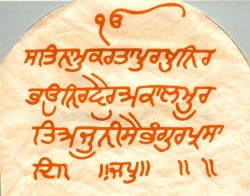Japji sahib
- For Japji Sahib Step by Step learning click here or for the newer version click here
Japji Sahib is the first sacred composition found in the main Sikh holy scripture called the Guru Granth Sahib. It is a famous and concise summary of the Sikh philosophy which was compiled by the founder of Sikhism and the first spiritual guide of the Sikhs known worldwide as Guru Nanak.
The composition consists of the Mool Mantar, an opening Salok or verse, a set of 38 Pauris or hymns, and a final closing Salok. This Bani called Japji Sahib, appears at the very beginning of the Guru Granth Sahib from Page 1 to Page 8 in the Holy Book of the Sikhs Nay! of Humanity. It is the most important Bani or 'set of verses' and is lovingly recited by all Sikhs every morning. The word ‘Jap’ means to ‘recite’/‘to ‘chant’/'to stay focused onto'. ‘Ji’ is a word that is used to show respect as is the word ‘Sahib’.
Introduction
This Bani was composed by the founder of the faith, Sri Guru Nanak Dev Ji who was the first of ten human Gurus of this faith. The Ten Gurus of Sikhism were responsible for the creation of this faith which took place over period 1469 to 1708 - a period of about 239 years.
At the point when the last of the Human Gurus departed this Earth, the Guruship was passed to the Holy Book, the Sri Guru Granth Sahib (SGGS). The SGGS is treated as a living Guru and the respect shown for its Commandments is unique. This Bani (composition) encompasses the spirit and theme of whole of the Sri Guru Granth Sahib.
The collections of hymns of Sikh daily prayer are often compiled separately in a small book form called Gutkas or "Nitnem" (meaning daily prayer) Gutkas. All Nitnem Gutkas start with Japji Sahib and contain other Banis (hymns) as well.
The description of Japji Sahib that follows is taken from "The Encyclopedia of Sikhism" by Harbans Singh (published in 1996 by the Punjabi University, Patiala):
| ...Japji is the most riveting Sikh Prayer recited by the devout early in the morning. The composition is not assigned to any particular raga or musical measure, as is the rest of the Scriptural text... "Japji is universally accepted to be the composition of Guru Nanak, the founding prophet of Sikhism, although, unlike other scriptural hymns and compositions, it remains anonymous without being credited individually to any of the Gurus..." |
Miracle of Japji
The Japji, and in particular the Mool Mantar, is a compilation which has freed humanity from thousands of years of superstition that had gripped their psyche of many common people. It is humanity's declaration of independence from soothsayers, yogis, priests, traditions, etc, whose validity had never been questioned. It is a direct communication between the human and master; it opened and established the communication path for this direct and close link of humanity with spirituality. It is a magical compilation which the Sikhs believe has not been equalled elsewhere.
All the falsehood in the name of religion that hitherto had been accepted as "ultimate truths" was challenged in the stanzas of the Japji. All rituals, practices, empty recitations of meaningless mantras, etc. has been accurately and summarily denounced as worthless. The Japji, places Waheguru/God above the most powerful of the gods from other mythology domains. However, it goes further and explains the infinite characters of Waheguru and Nanak, himself admits to being unable to describe the indescribable Waheguru.
The Japji, is scientifically accurate:
Jo kich payee so ekaa vaar
whatever is stored, was put once for all, enough for ever
which is another way of saying, Matter can neither be created nor destroyed.
The Japji, claims the existence of other worlds and planets, a concept that had not been entertained in the World at the time of its writing.
The miracle of Japji, happens when one embraces its message and is thus enabled to experience heaven (oneness with Waheguru) while still on this planet.
A personal account
An edited account of a personal experience of the miraculous power of Japji, as published in the www.aquariantimes.com Aquarian times
The story of one woman who was transformed at a cellular level by the sound current of Japji Sahib
Late one summer night in June 2003, unable to sleep, I sat at my computer listening to audio clips from a spiritual music website. I clicked on a Gurmukhi version of the Mul Mantra from a list of options available from the compilation of Japji by a male artist. During the few moments it took for him to sing this mantar in his resonant voice, what felt like a great far-reaching awakening began within me.
I thought to myself, "This is the most beautiful music I have ever heard," and while I "knew" that I had never heard it before, it felt familiar to me. This was my first personal encounter with Japji Sahib. I felt like I had found a precious jewel that I had forgotten I had. Re-encountering brought an instant, gentle, and complete breaking open of my heart. I began to cry. I played that 60 second audio clip over and over again, and sang with it, and cried, while my mind wondered vaguely in the background, "What does this mean?"
What do the words say?
Something about the artist’s singing of this particular mantra pierced me to my core. “What is this Japji?” I thought, “and if this one portion of it is so powerful, what dynamic is contained in its entirety?" I knew that I needed to explore this experience further.
I immediately ordered the CD of this Bani. When the CDs arrived in the mail, I immediately put on a pair of headphones and listened to the 45-minute Gurmukhi version. I wept my way through it. I found my mouth forming the sounds though I had no idea what the sounds might be and certainly no idea of what the words might mean in English.
But I found myself thinking, "Even though I have no idea what he’s saying, I know what he’s saying." (On a level far beyond left-brain comprehension and literal understanding of dictionary definitions, I knew the beauty and the grace and the transformative power of that sound current.)
Initially I deliberately chose not to question or analyze the way that this bani instantly took up residence within me. I knew that intellectual objections would arise, stemming from the fact that I had been studying Kriya Yoga since 1995 and had in fact been ordained as a swami in an order established by Paramahansa Yogananda.
I had found my medicine
I had studied Sanskrit and spent a great deal of my time in meditation chanting in Sanskrit. My immersion in Sanskrit mantra had helped me recover from a debilitating bout with chronic fatigue that had begun in 1994 and lasted for seven long and painful years. So part of my discomfort revolved around the idea that I "should" continue spiritual practices within "my own" tradition.
By the time I discovered Japji in June 2003, I had been trying for 3 1/2 years to come to terms with fibromyalgia. I had repeatedly altered and curtailed my physical activities, trying to find that magic level at which I could remain active without provoking continuous and excruciating pain. It eluded me.
I had taken several private sessions with a wonderful instructor to learn Kundalini Yoga sets specifically designed to correct the internal imbalances related to fibromyalgia and fatigue. I wanted very much to be consistent with these practices, but my body was not capable of doing them on a regular basis. When I had finally regained enough energy and vitality to begin moving in and through my life again in 2000, fibromyalgia symptoms flared up with full force and incapacitated me in a new way. Finally in 2002 I stopped everything, altogether.
The pain was taken away
During the course of a year the pain decreased, eventually allowing me once again to sleep though the night. By the summer of 2003 I felt "plateaued"- happy to have reached a relatively pain-free resting place, but also stuck there. Tentative attempts at walking more than a block or two or doing gentle yoga caused rumblings below the surface which signalled that the volcano of pain could be activated with little provocation, and I was very resistant to triggering that cycle again. I thought I needed to commit myself again to intense japa (reciting), but didn’t feel drawn to any particular Sanskrit mantra.
Such was my state of affairs when I visited the spiritual music website and clicked on the Japji audio clip. I knew instantly, without even thinking it, that I had found the mantra that I needed - or that it had found me. I knew that it resonated in me and that I resonated with it and that chanting it was going to change my molecular structure - was going to literally rearrange my DNA, transform me at a cellular level, and gradually move me up and off the plateau I was resting on.
Intuitive and instant connection
I knew all of this within the first minute of hearing the audio clip-knew it completely and wholly as though someone had pressed an imprint of its truth on my third eye and I had absorbed it without needing to mentally process it. I had a fairly good idea of what my "logical" objections to pursuing this path might be, and I didn’t want to give them precedence. I wanted to have the experience first and then judge it, rather than pass a judgment which would keep me from having the experience.
In June 2004, I attended the Naad of Japji workshop in New Mexico, USA. The concentrated immersion in the sound current accelerated my physical healing in a way that I couldn’t have imagined. At this point in my life it had been over two years since I had engaged in any type of regular physical activity. One day during the Japji course we were asked to do a meditation that involved holding our arms over our heads for 11 minutes.
I thought, "I can’t even hold my arms over my head for 11 seconds because my muscles are so weak, and even if I could, the pain would be unbearable." And then I thought, "That might not be true anymore. Let’s test it." I did the meditation for 11 minutes. My arms were strong enough. And although it was somewhat painful, it was the predictable pain of the nervous system adjusting and the muscles working. At that moment I knew I was on my way off that plateau.
The miracle continued
When I returned to Chicago after the Japji course, I designed a "Return to Exercise" program for myself and repeatedly renewed my 40-day commitment to chant Japji. In June 2005 I returned to New Mexico centre for more Japji! By this time I was able to engage in some sort of cardiovascular exercise for an hour at a time, four or five days a week, at a moderate to intense level, as well as lift weights three times a week.
I was also getting out of bed consistently at 4:00 a.m. for sadhana, and I had gradually increased the amount of time I spent at my job to 40 hours weekly-something I had not been physically capable of doing since 1995. In New Mexico, I was able to participate in group sadhana, which I had not been able to do the previous summer.
It’s now June 2006. I’m still chanting Japji every day. I’m also attending a weekly Kundalini Yoga class, doing a yoga set in my own morning sadhana, and preparing to take Kundalini Yoga Teacher Training in the fall!
It has been a great blessing to be engaged in a transformative relationship with Japji Sahib, and to discover through experience that “at the root of all there is only the One.”
Learning Japji
At Japji Sahib Step by Step you can read and listen to Japji in Gurmukhi/Punjabi. The Bani is written in Roman script and it has translation in English. Click on any of the highlighted options 1 to 38 or M for Mool Mantar or S for Salok and you will be able to listen and also read this beautiful Bani.
See also
- Mool Mantar
- Japji Sahib Step by Step newer version
- Japji Sahib Step by Step
- Mool Mantar and its Perception
- Learn Gurbani
- Japji in English
- Japji in Roman text
- Japji in Gurmukhi
- Japji in French
- Japji in Dutch / Nederlands
- Japji memory aid
- Japji in Gurmukhi with links to meanings
- Japji sahib translation
Downloads
- Download Powerpoint file
- Japji Sahib - Android Apps on Google Play
- Japji Sahib International - iPhone and iPad App on AppStore
- Download Japji sahib in Original Gurmukhi only (Blue background) in pdf format
- Download Japji sahib in Original Gurmukhi only (white background) in pdf format
- Download Japji sahib in Original Gurmukhi, Roman transliteration and English translation in pdf format
- Download Japji sahib in Original Gurmukhi, Roman transliteration and English translation in pdf format
- Download Japji sahib in Original Gurmukhi, Roman transliteration and English translation divided by each Pauri (in pdf format)
- Download Japji sahib in Original Gurmukhi only in word doc format
- Download Japji sahib in Original Gurmukhi, Roman transliteration and English translation in word doc format
External Links
Video links
- Holy Recitation and Meaning of Mool Mantar and Ik Onkar
- Beautiful recital of JAPJI SAHIB - RECITE ALONG - WORDS OF AKAL 34 min - Read, listen, understand and recite
- Japji Sahib - Sikh Prayer - Read, listen, understand and recite 19.2 mins
- Japji Sahib - Sikh Prayer
- Nitnem (Jap Ji Sahib) - line-by-line video translation
- Japji Sahib by WorldGurudwara.com- Read Along: Part 1 Part 2
- Japji Sahib - in Hindi, Urdu and English
Audio links
- Japji Sahib - Bhai Jarnail Singh (Damdami Taksaal)
- Japji Sahib in 10 Minutes
- Japji Sahib - Bhai Niranjan Singh
- JapjiSahib.mp3 - Download 1.826M or Play 15.34 min
- Sant Singh Maskeen - Japji Sahib Veechaar
- Darshan Singh (Dhakki Sahib Wale) - Taksali Nitnem - Japjee Sahib
- Harbans Singh (Jagadhari Wale) - Nitnem - Japji Sahib
- Jarnail Singh - Damdami Taksal Nitnem - Sri Jap Ji Sahib
- Rajnarind Kaur - Bani Pro 1
Text of Japji Sahib
- Japji Sahib Gurmukhi, English Translation and Transliteration
- Audio & Written Display from AllaboutSikhs.com
- Written text of Japji Sahib
Other Links
- Japji Sahib - Information & Downloads on SikhRoots.com
- Japji Sahib Original, English Transliteration, Punjabi & English Translation
- Japji Sahib Original, English Translation and Transliteration]
- Gurbani by SriGranth.com
- Gurbani by Sikhitothe Max.com
- Read Jap Ji Sahib Online
- Japji Sahib in Gurmukhi
- Japji Sahib Contemporary Translations in English
- Sacred-texts.com English translation
- sikhnet.com Post-Modern Translation of Japji Sahib
- Japji by James G. Lochtefeld
- Video learning - Japji Sahib: The Song of the Soul
Suggested Reading
1. Japji (English Translation) - Sher Singh MSc Kashmir
2. Jap Ji Sahib - Vyakhya, Vichar Darshan atey Kala - Dr. Gurcharan Singh Mehta
3. Japji Viyakhya dey Prasang vich Rajneesh di Asliyat - Dr. Karamjeet Singh
The book: "The Japji - Guru Nanak Dev's Master Key-Holy To The Mystery Of Deification Of Man" was published by Bhai Sher Singh, MSc, Kashmir on August 1, 1950.
5. Japuji Exegesis and Poetic Rendering - Dr. S.S. Bhatti
6. Translation of the Japji - M. Macauliffe
7. Sri Japji Darpan - Amarjit Singh Dhawan
8. The Japji - Ha! Guru Nanak's Honey!! - Sher Singh MSc Kashmir
9. The Japu of Guru Nanak - Sirdar Kapur Singh
10. The Region of Grace - Sirdar Kapur Singh
11. Sri Japu Nisan - Kartar Singh Dakha
12. Dua-E-Sahari (Japji Sahib ka Urdu tarjuma) - Kartar Singh Kaimbalpuri
13. Vird-E-Haq (translation of Japji Sahib in Urdu verse) - Master Lal Singh Anand Khalsa
14. Guru Nanak's Japji and Sohila-Arti - Prof. Puran Singh
15. Jap Vichar - Japji Sahib da Bahu-Pakhi Adheyan - Prof. Prakash Singh
16. Jap Ji Sahib - Vyakhya, Vichar Darshan atey Kala - Dr. Gurcharan Singh Mehta
| Gurus: | Nanak Dev | Guru Angad | Amar Das | Ram Das | Guru Arjan | Har Gobind | Har Rai | Har Krishan | Tegh Bahadur | Gobind Singh | Guru Granth Sahib | Sikh Bhagats |
| Philosophy: | Sikh Beliefs | Simran | Sewa | Beliefs and Principles | Underlying Values | Prohibitions | Technique and Methods | Other observations | Technique and Methods |
| Practices: | Ardas | Amrit Sanskar | Chardi Kala | Dasvandh | Five Ks | Kirat Karni | Kirtan | Langar | Naam Japna | Simran | Three Pillars | Vand Chakna | Five Evils | Five Virtues |
| Scripture: | Guru Granth Sahib | Sikh Scripture | Dasam Granth | Ek Onkar | Waheguru | Bani | Mool Mantar | Japji Sahib | Jaap Sahib | Chaupai | Anand Sahib | Tav-Prasad Savaiye | Rehras | Sukhmani |
| More: | History | Gurdwaras | Harmandir Sahib | Khalsa | Khanda | Names | Places | News | Satguru | Sikhs | Bhagat Farid | Bhagat Kabir | Websites | Biographical | Terms |



